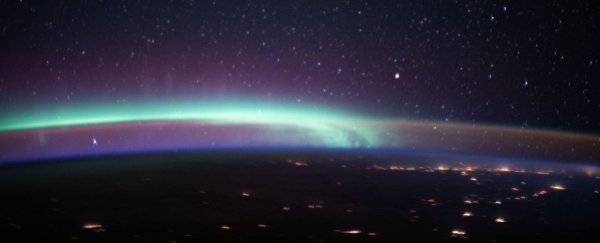Earth is a genuinely magical place.
We know that's not the sort of thing you'd expect to read on a science website, but just take a look at the photo above - a pre-dawn picture taken by an Expedition 62 crew member on the International Space Station (ISS) back in March.
In this image, taken when the ISS was flying just south of the Alaskan Peninsula, the fantastic colours you're seeing are particles in Earth's upper atmosphere interacting in different ways, resulting in two entirely different atmospheric phenomena in one picture.
Truly magical to look at, but also easily explained with some science.
The first phenomenon is the aurora - the glowing green, red-tipped phenomenon on the left side of the image. Auroras occur when charged particles from the solar wind hit Earth's magnetosphere – a kind of protective cloak where such particles are at the whims of our magnetic field.
Mixed with atmospheric gases such as oxygen and nitrogen, the particles create the colours we know as the aurora.
Excited by solar wind, oxygen atoms at the highest altitude release this excess energy as the red glow, while the green is caused by excited oxygen or nitrogen molecules releasing energy at lower altitudes.
But the aurora is only one part of this particular shot. Moving right on the image above, take a look at the yellow-red band of light right above the curve of our planet. It's called an 'airglow', and it's more subtle than the aurora, but just as cool.
To understand airglow – more specifically nightglow – you need to remember that the night sky is never completely dark, not even once you've extracted light pollution, starlight, and diffuse sunlight.
Instead, atoms produce 'emissions' from being in their excited state. For example, oxygen that's been broken apart during the day recombine and release their extra energy as photons at night. Nitrogen molecules and reactions between nitrogen and oxygen contribute to this glow as well.
 Earth's nightglow. (NASA)
Earth's nightglow. (NASA)
The photons released in this case appear green, as in this image above, but yellow sometimes occurs at a lower layer (around 80 to 100 kilometres above the surface of Earth).
Meteors break up in this layer of the atmosphere, and release sodium atoms into the air, hence it's aptly named the sodium layer; excited sodium atoms will create a distinctly yellow glow.
As a bonus, the rising sun behind Earth is causing the edge of the planet to appear dark blue. This occurs for the same reason that the sky is blue during the day – when sunlight hits the molecules in our atmosphere, blue light (one of the shortest wavelengths) is scattered, while other coloured light is mostly let through.
We told you, absolutely magical.
